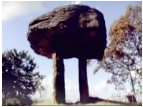마제석검과 마제석촉은 청동기시대 고인돌무덤에서 대표적으로 출토하는 도구다. 석검과 석 촉은 무기, 의기로 사용되었으며, 남자들이 제작하고 소유하였다. 그런데 이러한 마제석검과 마...
http://chineseinput.net/에서 pinyin(병음)방식으로 중국어를 변환할 수 있습니다.
변환된 중국어를 복사하여 사용하시면 됩니다.
- 中文 을 입력하시려면 zhongwen을 입력하시고 space를누르시면됩니다.
- 北京 을 입력하시려면 beijing을 입력하시고 space를 누르시면 됩니다.
https://www.riss.kr/link?id=A101745835
- 저자
- 발행기관
- 학술지명
- 권호사항
-
발행연도
2015
-
작성언어
Korean
-
주제어
마제석검 ; 마제석촉 ; 고인돌 ; 조상신상 ; 여신상 ; 영일만 ; Majaesukgeom ; Majaesukchok ; Dolmen ; ancestor ; goodness ; Youngilman
-
자료형태
학술저널
-
수록면
37-55(19쪽)
- 제공처
-
0
상세조회 -
0
다운로드
부가정보
국문 초록 (Abstract)
마제석검과 마제석촉은 청동기시대 고인돌무덤에서 대표적으로 출토하는 도구다. 석검과 석 촉은 무기, 의기로 사용되었으며, 남자들이 제작하고 소유하였다. 그런데 이러한 마제석검과 마 제석촉이 영일만 일대 포항, 경주지역의 암각화에 등장하고 있다. 영일 인비리 고인돌 개석에는 석검과 석촉 문양이 새겨져 있는데, 석검의 검파식(劍把飾)에서 장식(裝飾)이 등장한다. 석검의 검파식에서 파생된 검파형 문양이 흥해 칠포리에서 발달하고, 마제석촉이 경주 금장대 암각화에 서 인형상으로 묘사되어 나타나는데, 이 신상암각화는 조상신상(祖上神像)을 표현한 것으로 보 인다. 인비리의 석검문양은 남자생식기 문양으로 변모하는 모습도 보이고. 석검의 검파식이 석 검에서 분리되어 검파형으로 발달하면서 독자적인 신상암각화로 변모한다. 검파형 암각화는 여 자생식기 암각화와 함께 한곳에 새겨져 여자상 또는 여신상(女神像)으로 해석이 가능해졌다. 그 리고 여자생식기는 실물모사형부터 역삼각형의 도상까지 다양하게 제작되어 있다. 이와같이 칠 포리와 금장대 암각화에서 마제석검과 마제석촉의 주인공들이 종족번식과 풍요다산을 기원하는 신앙의례로서 석검형·석촉형·검파형·여자생식기형 암각화를 발달시켰다. 이처럼 성적 상징 의 암각화가 영일만 일대에서 발달할 수 있는 배경에는 장식석검이 있었다. 장식석검은 마제석 검의 검파식에 여러개의 구멍을 갈아파서 장식한 석검을 말하는데, 포항 흥해, 경주지역을 중심 으로 하는 경상남북도에서 출토하고 있다. 검파형 암각화도 흥해 칠포리에서 발달하여 경상남 북도 전역으로 확산되어 갔다는 점에서, 장식석검과 검파형 암각화는 상호 연관성이 매우 깊다.
다국어 초록 (Multilingual Abstract)
Majaesukgeom (a stone sword) and Majaesukchok (a stone arrowhead) are tools excavated from Dolmen. They were made during the period of Bronze. The stone swords and stone arrowheads were made by men and used as weapons and vessels for ritual ceremonies...
Majaesukgeom (a stone sword) and Majaesukchok (a stone arrowhead) are tools excavated from Dolmen. They were made during the period of Bronze. The stone swords and stone arrowheads were made by men and used as weapons and vessels for ritual ceremonies. These appear in petroglyphs found in Pohang around Youngilman and Kyeongju. There are stone swords and stone arrowheads carved on Dolmen in Inbi-ri, Youngil and the stone swords have a grip-like shape. This shape was developed in chilpo-ri, Hoonghae. Stone arrowheads appear as a doll in petroglyphs found in Gumjangdae in Kyongju, which looks like an ancestor. The stone sword-shape found in Inbi-ri has turned into a shape of man’s genital. The gumpa (grip of a stone sword) was separated from the stone sword and became an independent shape and it was called gumpahyeong (gumpa-shape). The gumpahhyeong petroglyph was interpreted as a shape of a woman or a goodness since it was carved with woman’s genital. The shapes of them were various, such as an inverted triangle and a copy of a woman’s genital. The petroglyphs carved in Sukgeom-shape, sukchok-shape, gumpa-shape, and woman’s genitalshape were developed via Majaesukgeom and Majaesukchok found in Chilpo-ri and in Gumjangdae for ritual ceremonies for breeding of the race and fertility. The back ground of the development of the petroglyphs that have genitals of male and female was Jangshiksukgeom. The Jangshiksukgeom is a sukgeom that has many holes on the grip of Majaesukgeom, which come from Gyeongsangnamdo and Gyongsangbuk-do, especially Pohang in Honghae and Kyeongju. The petroglyphs that have a Gumpa-shape were also developed in Chilpo-ri in Honghae and went to Gyeongsangnam-do and Gyongsangbuk-do, which suggests Jangshiksukgeom and Gumpa-shaped petroglyphs are connected each other.
목차 (Table of Contents)
- <국문초록>
- I. 서론
- II. 한국 암각화에 등장하는 성의 표현과 상징
- III. 한국 암각화에서 성적 표현 양식
- IV. 석검형·석촉형·검파형 암각화의 상징성
- <국문초록>
- I. 서론
- II. 한국 암각화에 등장하는 성의 표현과 상징
- III. 한국 암각화에서 성적 표현 양식
- IV. 석검형·석촉형·검파형 암각화의 상징성
- VI. 맺음말
- <참고문헌>
-
동일학술지(권/호) 다른 논문
-
- 한국암각화학회
- 한국암각화학회
- 2015
-
선사시대 바위 그림에 표현된 사람 형태에 대한 일 고찰 - 몽 베고(mont Bego), 발 카모니카(Val Camonica), 타실리의 바위 그림을 중심으로 -
- 한국암각화학회
- 한국암각화학회
- 2015
-
- 한국암각화학회
- 한국암각화학회
- 2015
-
- 한국암각화학회
- 한국암각화학회
- 2015




 eArticle
eArticle





